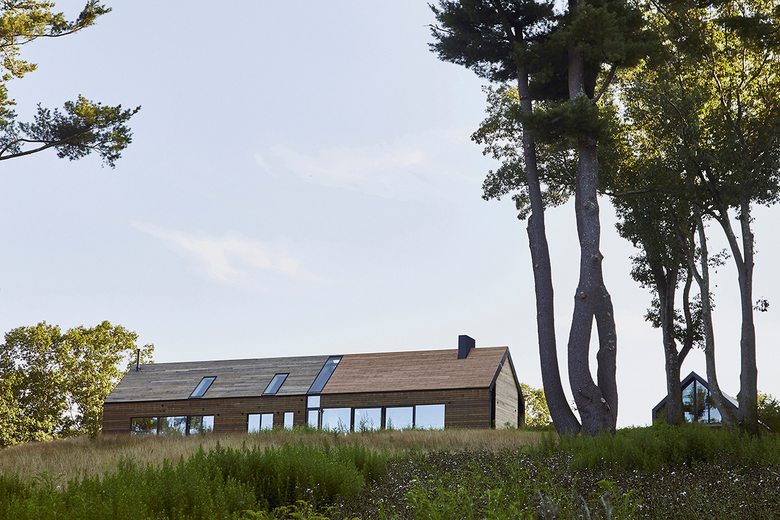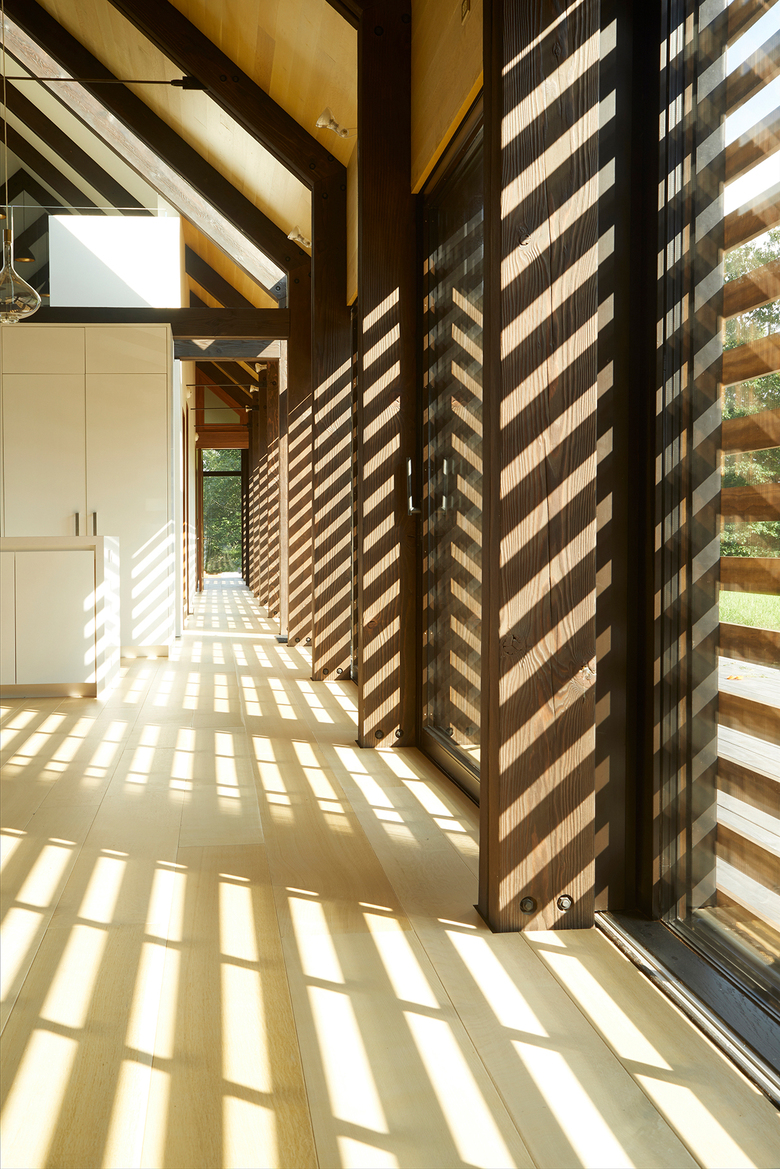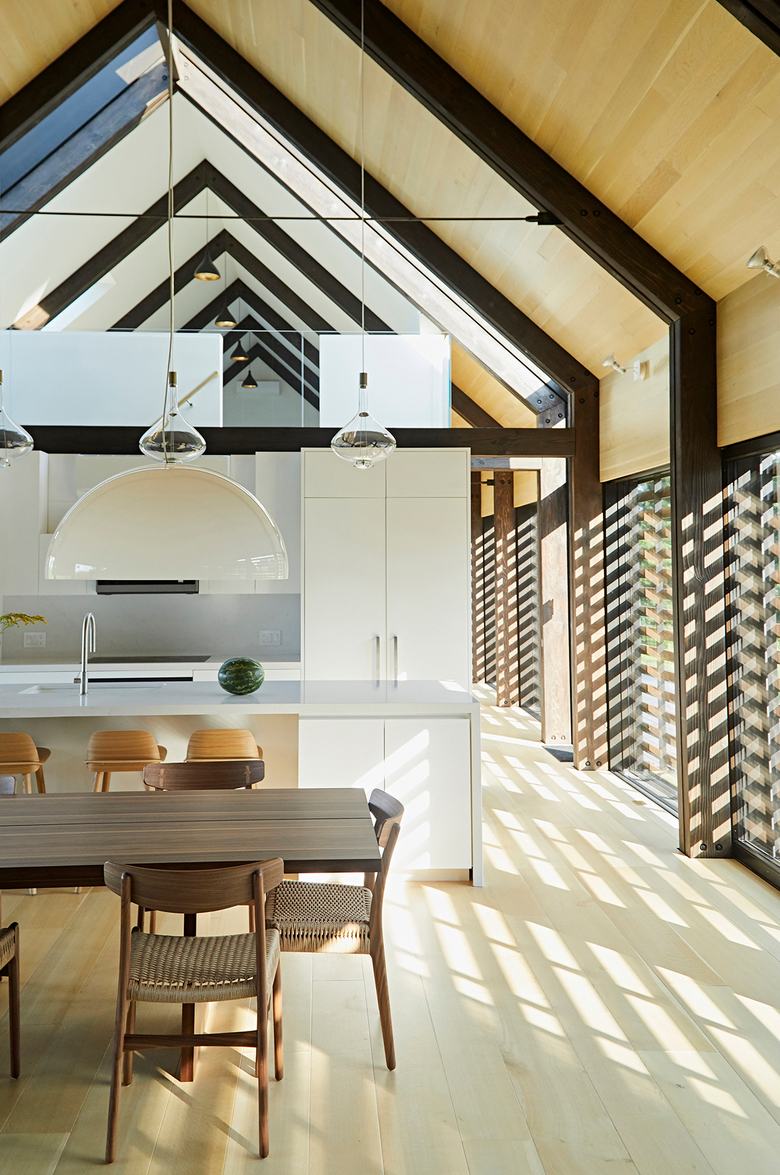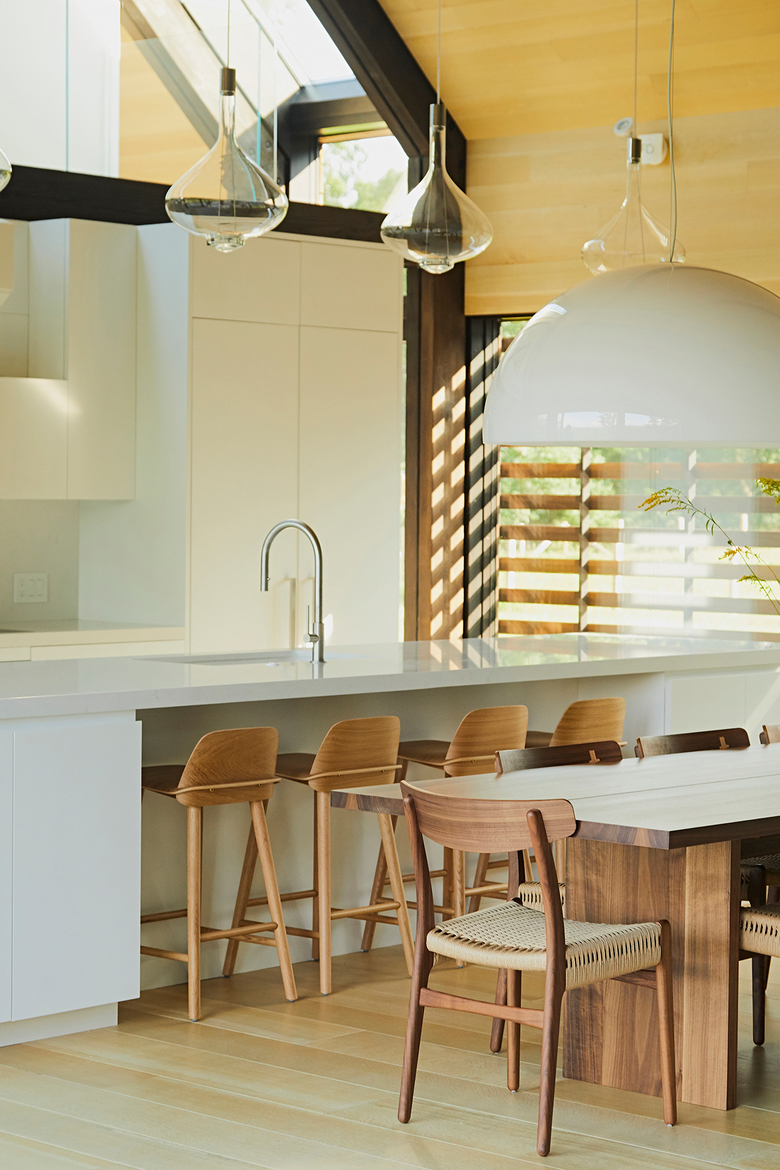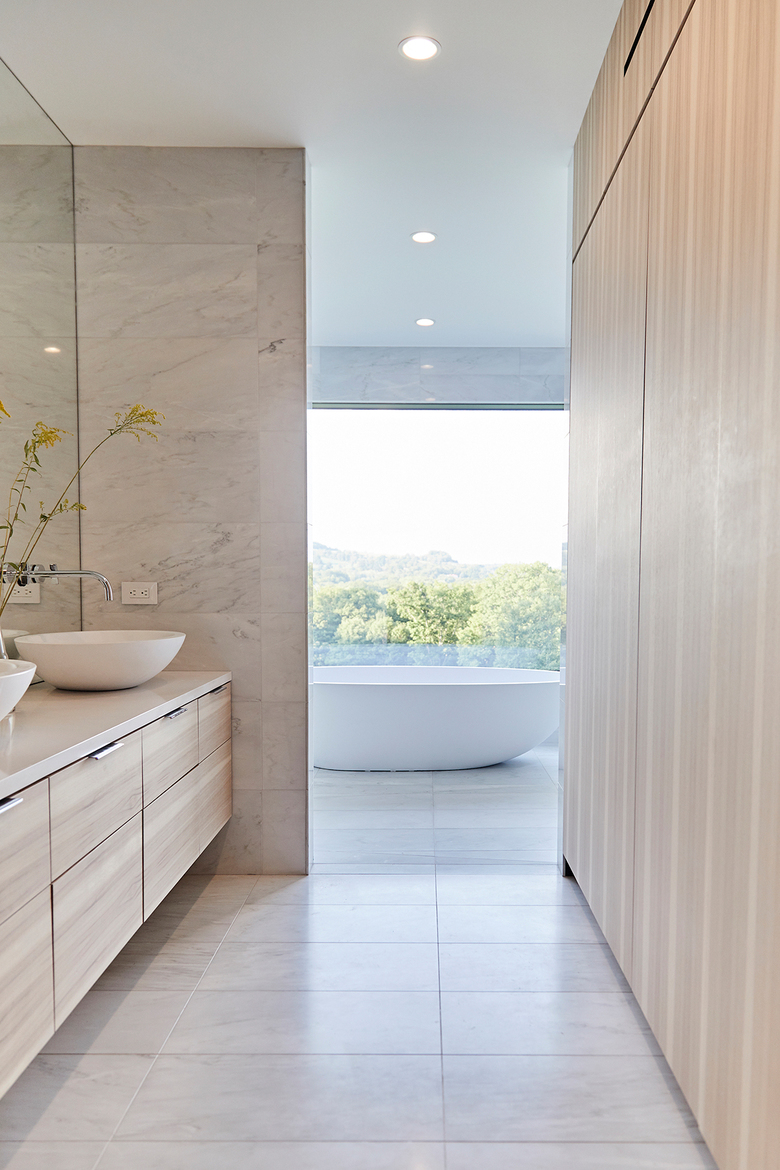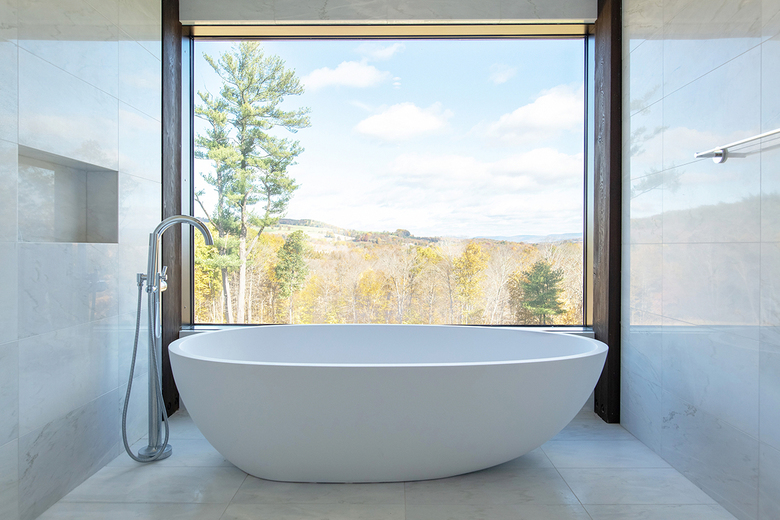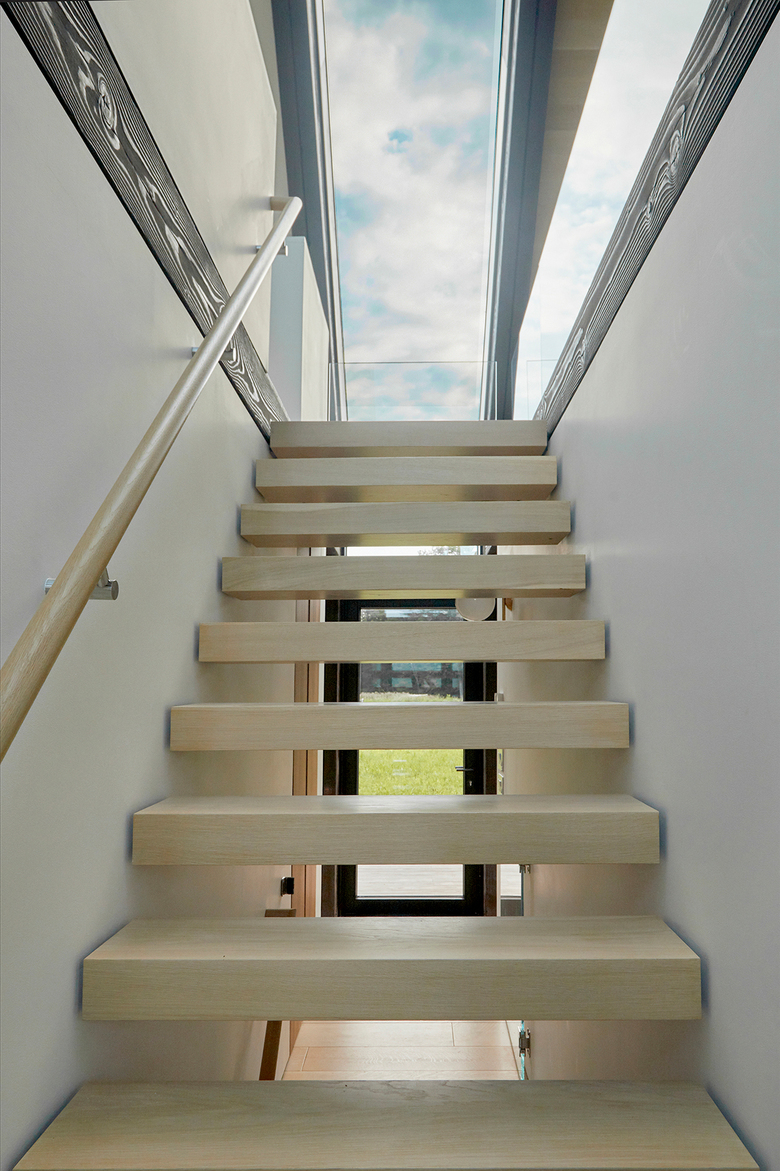U.S. Building of the Week
Silvernails
This weekend house takes its name from an old railroad junction in the small town of Gallatin, about 100 miles north of New York City. Inspired by the barns that still dot the area, the two structures take on gabled forms, looking at home on the property's many acres. Amalgam Studio answered a few questions about Silvernails.
Location: Gallatin, New York, USA
Client: Withheld
Building Designer: Amalgam Studio
Design Principal: Ben Albury
Structural Engineer: Ross Dalland Engineers
MEP/FP Engineer: Baukraft Engineering
Landscape Architect: Jamie Purinton
Lighting & Interior Designer: Amalgam Studio
Contractor: Black Oak Builders
Civil Engineer: Weston & Sampson
Envelope Specialist: 475 High Performance Building Supply
Woodwork & Cabinetry: Rowan Woodwork
Site Area: 120 acres
Building Area: 6,676 sf
Set on a mountaintop on 120 pristine rural acres of woodlands with views towards distant mountains and a nearby river, two buildings and an outdoor pool make up the farm-like complex. The project is currently a weekender but is designed to change over time into a full-time residence. The main house is split over three levels, with four bedrooms and a total of five bathrooms, with a floor area of 5,087 sf. The detached carriage house is two levels, with a three-car garage and workshop with a multi-purpose loft space above, with a floor area of 1,589 sf.
The house is "modern vernacular": Modern relates to the latest in material technology, contemporary aesthetics, open-planning, detailing, linear configuration, state-of-the-art energy efficiency and comfort levels. Whereas vernacular relates to the shape, massing, siting, visual language, construction methodology, materiality and durability of historic, traditional, local architecture.
Modern Barn Concept:
Conceptually the house design evolved from the architect's research into three historic archetypes: the New World Dutch, Three-Bay English, and New England Barns, all built throughout the area during the 18th and 19th centuries. These archetypes helped inform the strong gable form, interior planning, and overall massing. They also inspired the use of exposed structural framework, cathedral ceilings, loft spaces, large sliding glass doors, natural stone to the basement walls, wood lining to the interiors, and wood cladding to exterior walls and roofing.
Structure:
The 100ft long main house structure is made up of fourteen repetitive "bent" frames spaced at 8-ft centers. These 22-ft wide, 21-ft high charred Douglas Fir frameworks were raised one-by-one from the horizontal and bolted upright into place within five hours.
Local Materials:
A clear focus on local materials informed interior finish selections. Tree species endemic to the heavily wooded 120-acre property were selected for warmth and character: white oak for flooring and lining, walnut for cabinetry, hickory for feature vanity units. Local granite, slate and domestic quarried stone guided choices for the chimney hearth, wet areas and basement masonry respectively. The palette progresses from the soft whiteness of the loft, to the clean warmth of the ground floor, to the raw, harder, elemental and darker spaces of the basement.
Views:
Careful control of light and the framing of views were considered for each fenestration element. The fully glazed entrance and stairwell deliberately aligns with a mid-distant stand of pine trees: a favorite perch for a resident Bald Eagle. Four huge square-shaped lift & slide glass doors open up to the north and south decks for more expansive, 180 degree vistas, providing a strong connection between indoors and outdoors.
Selective smaller, north-facing windows are detailed as picture windows to maximize the expansive views out towards the distant hills and mountain ranges beyond. Additionally, bedroom window seats encourage active use and inspire further contentment, appreciation and contemplation of the outdoors, whilst being comfortably indoors.
Private areas of the end bedrooms have unique full-height framed views down to the pristine trout-filled river waters of the Roeliff Jansen Kill. Horizontal basement windows are at a high-level emphasizing the wild flower meadows stretching beyond. Tall, slanting north-facing skylights in the upstairs loft become optimal stargazing portals on a clear-sky night. The main galleria corridor running the length of the house frames vertical views of nearby deciduous oak woodlands at either end.
Originally the scope of work included a one-bedroom guesthouse situated near the river, designed as a seasonal summer house or rental river house. The construction of this house was postponed to a later stage. We instead designed the carriage house loft to be converted into a guesthouse in the near future, with all necessary plumbing completed and capped, awaiting conversion. The main house basement was designed as a half basement but was expanded to a full basement during the bidding process. But generally speaking, the ideas, scale, massing, budget and materials of the design remained true for the remainder of the project.
Energy Efficiency:
Specifically, the architects developed a high-performance facade of super-insulation, air-tight membranes, rain screens and triple glazing throughout. Adjustable exterior sun-shading devices and in-wall heat-recovery ventilation units help ensure an adaptable and comfortable interior environment, with continuous fresh air, year round.
Operable windows and sliding doors are positioned to encourage cross-ventilation. Heating is provided with fireplaces and wood stoves, or with energy-efficient multi-split heat-pump air-conditioning systems. All appliances are electric. The house requires no fossil fuels. Artificial lighting is almost all LED.
Downstairs, the underground wine cellar is completely passive and without the need for temperature control. Upstairs, daylighting is harvested by multiple skylights. The central skylight also brings light down into the basement.
Resiliency:
The house was designed and detailed with a 100 year time period in mind. All materials were selected to be durable, to age naturally over time, and need little, if any, maintenance. Rooms and spaces were designed to be adaptable and flexible, performing multiple functions as the family grows. The entire upstairs loft can be modified over time into nursery, play space, rumpus room, drawing room, or divided into distinct storage, study and office loft spaces as needed. Similarly, the upstairs loft space in the carriage house was designed to allow future conversion into a guest house, with plumbing capped in place for a possible guest ensuite.
Most design decisions and detailing were bolstered with multiple rationales and purposes. The south-facing facade sunshades help showcase this attitude of longevity, resilience, purposefulness and flexibility. These hand-operated, European engineered, finely detailed, pneumatic, tilt-up screens ostensively restrict solar gain during the warmer months. Additionally they create an ever-changing poetic play of sunlight and shadow throughout the day along the entire length of the house’s main corridor.
When opened completely upwards they provide shade for the expansive exterior deck, encouraging outdoor entertainment beneath, acting like a pergola or verandah. Conversely, kept open during cold months of low sun height, they allow for additional solar heat gain. In terms of resiliency, the shades, when closed down, act as hurricane shutters in the colder months against mini-tornadoes, nor'easters, polar vortexes, bomb-cyclones and other future severe inclement weather events related to climate change. If accidentally left open during a snowstorm they are designed to tip downwards under the weight of snow, cleverly shedding the snow in the process.
The cladding to the entire exterior, including the decking and roofing, is a new product to the US called Kebony, invented in Norway. Described as a sustainably sourced plantation pine modified with bio-based liquid, it exhibits hardwood characteristics. This hi-tech natural wood is maintenance-free, unpainted, unstained, insect and mold resistant, dimensionally stable and even warrantied for 30 years.
Email interview conducted by John Hill.
